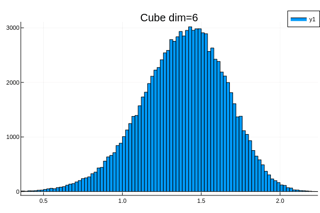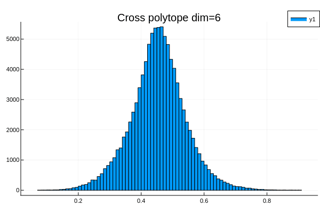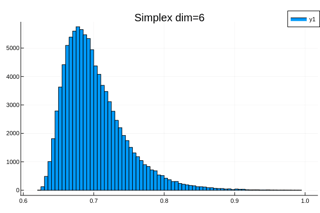$\newcommand\bar\overline$
Let us first find asymptotics of the radial distribution of a random point uniformly distributed on the standard/probability simplex
$$S_n:=\{(x_1,\dots,x_n)\in[0,\infty)^n\colon x_1+\dots+x_n=1\}.$$
The distribution of such a random point coincides with that of the random vector
$$\frac{(X_1,\dots,X_n)}{X_1+\dots+X_n},$$
where $X_1,\dots,X_n$ are iid standard exponential random variables (r.v.'s) (see e.g. Fisher, bottom of p. 55--top of p. 56). So, the distribution of the distance of such a random point from the origin is that of
$$R_n:=\frac{\sqrt{X_1^2+\dots+X_n^2}}{X_1+\dots+X_n} \\
=\frac{\sqrt{n\bar{X^2}}}{n\bar X}=\frac{\sqrt{1+2\bar Y+\bar{Y^2}}}{\sqrt n(1+\bar Y)} \\
=\sqrt2\,\frac{\sqrt{1+\bar Y+(\bar{Y^2}-1)/2}}{\sqrt n(1+\bar Y)},$$
where $\bar X:=\frac1n\,\sum_1^n X_i$, $\bar{X^2}:=\frac1n\,\sum_1^n X_i^2$, $\bar Y:=\frac1n\,\sum_1^n Y_i$, $\bar{Y^2}:=\frac1n\,\sum_1^n Y_i^2$, $Y_1:=X_i-1$, so that the $Y_i$'s are iid with $EY_i=0$ and $EY_i^2=Var\,Y_i=1$.
Now to get the asymptotic distribution of $R_n$ (as $n\to\infty$) we use the multivariate delta method (see e.g. this paper), which is here basically a linear approximation of $R_n$ based on the fact that $\bar Y$ and $\bar{Y^2}-1$ are $O_P(1/\sqrt n)$. So,
$$R_n\approx\sqrt2\,\frac{1+\bar Y/2+(\bar{Y^2}-1)/4}{\sqrt n(1+\bar Y)} \\
\approx\frac{\sqrt2}{\sqrt n}\,(1+\bar Y/2+(\bar{Y^2}-1)/4)(1-\bar Y) \\
\approx\frac{\sqrt2}{\sqrt n}\,(1-\bar Y/2+(\bar{Y^2}-1)/4),$$
where $A_n\approx B_n$ means $A_n=(1+O_P(1/\sqrt n))B_n$.
By the central limit theorem, $1-\bar Y/2+(\bar{Y^2}-1)/4$ is approximately normal with mean $1$ and variance $Var(1-Y_1/2+(Y_1^2-1)/4)/n=1/(4n)$, we conclude that $R_n$ is approximately normal with asymptotic mean $\sqrt2/\sqrt n$ and asymptotic standard deviation $(1/\sqrt2)/n$.
By symmetry, the radial distribution of a random point uniformly distributed on the standard cross polytope coincides with the radial distribution of a random point uniformly distributed on the "sub-probability" simplex
$$\tilde S_n:=\{(x_1,\dots,x_n)\in[0,\infty)^n\colon x_1+\dots+x_n\le1\}$$
and thus, by homogeneity, with the distribution of the r.v.
$$\rho_n:=R_n B_n,$$
where $B_n$ is a r.v. independent of $R_n$ and having the beta distribution with parameters $1$ and $n$, so that $EB_n=1-O(1/n)$ and $Var\,B_n=O(1/n^2)$. Thus, $B_n=1+O_P(1/n)$. We conclude that the asymptotic radial distribution of a random point uniformly distributed on the standard cross polytope is the same as that of a random point uniformly distributed on the standard simplex.



